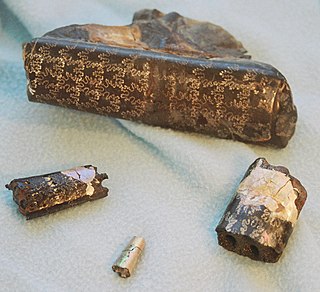
Nautiloids are a large and diverse group of marine cephalopods (Mollusca) belonging to the subclass Nautiloidea that began in the Late Cambrian and are represented today by the living Nautilus and Allonautilus. Nautiloids flourished during the early Paleozoic era, where they constituted the main predatory animals, and developed an extraordinary diversity of shell shapes and forms. Some 2,500 species of fossil nautiloids are known, but only a handful of species survive to the present day.

Baculites is an extinct genus of cephalopods with a nearly straight shell, included in the heteromorph ammonites. The genus, which lived worldwide throughout most of the Late Cretaceous, was named by Lamarck in 1799.

Orthoceras is a genus of extinct nautiloid cephalopod restricted to Middle Ordovician-aged marine limestones of the Baltic States and Sweden. This genus is sometimes called Orthoceratites. Note it is sometimes misspelled as Orthocera, Orthocerus or Orthoceros.
Rayonnoceras is a genus of extinct cephalopods that lived around 325 million years ago during the Carboniferous. Although they resemble earlier actinocerids they are now though to belong to the Pseudorthocerida

Septa are thin walls or partitions between the internal chambers (camerae) of the shell of a cephalopod, namely nautiloids or ammonoids.

Orthocerida is an order of extinct Orthoceratoid cephalopods also known as the Michelinocerida that lived from the Early Ordovician possibly to the Late Triassic. A fossil found in the Caucasus suggests they may even have survived until the Early Cretaceous. They were most common however from the Ordovician to the Devonian.

Plectronocerida is a primitive order from which subsequent cephalopod orders are ultimately derived.
Michelinoceras is the oldest known genus of the Michelinocerida, more commonly known as the Orthocerida, characterized by long, slender, nearly cylindrical orthocones with a circular cross section, long camerae, very long body chambers, and a central or near central tubular siphuncle free of organic deposits. Septal necks are straight; connecting rings cylindrical and thin. Cameral deposits are well developed. A radula has been found in one species, with seven teeth per row. It had ten arms, two of which formed longer tentacles.

Ormoceras is an actinocerid nautiloid genus and type for the family Ormoceratidae, found in North America from the late Chazyan through the early Cincinnatian of the Middle and Upper Ordovician, but which continued through the Devonian worldwide.
Armenoceras is a genus of actinocerid nautiloid cephalopods whose fossils ranged from the late Whiterockian Stage in the early Middle Ordovician, through the remainder of the period and on into the Upper Silurian. It is the type genus of the family Armenoceratidae.
Murchisoniceras is an extinct genus of cephalopod Nautiloid, that lived during the Silurian from 425 to 416 mya, in what would be Europe, existing for approximately 9 million years .
Jovellania is a genus of extinct prehistoric nautiloids from the order Oncocerida known from the Lower Devonian of Europe. Nautiloids form a broad group of shelled cephalopods that were once diverse and numerous but are now represented by only a handful of species in two genera.
Wardoceras is an extinct nautiloid genus from the late Early Ordovician of Western Utah, assigned to the orthocerid family, Michelinoceratidae
Geisonocerina is an extinct genus from the carnivorous nautiloid cephalopod order Orthocerida that lived in what would be North America, Europe, and Asia during the Ordovician through Permian from 449—290 mya, existing for approximately 159 million years .
Sactoceras is an extinct nautiloid cephalopod that lived during the Ordovician and Silurian in what would become North America, Europe, and Asia.
Macroloxoceras is a large pseuorthocerid from the upper Devonian of Central Colorado and Southern New Mexico with features resembling those found in actinocerids. Pseudorthocerids and actinocerids are extinct nautiloid cephalopods, generally with long straight shells and expanded siphuncle segments filled with organic deposits.
Centroonoceras is a middle Ordovician cyrtoconic nautiloid cephalopod, otherwise similar to the orthoconic Sactorthoceras and also included in the Sactorthoceratidae. It was named by Kobayashi, 1934, and has been found in Korea and in New York state in the eastern U.S.
Augustoceras is a genus of nautiloid cephalopods included in the order Oncocerida and family Valcouroceratidae. It is known form the Middle and Upper Ordovician of Kentucky and Ohio in the US.
Cyrtogomphoceras is a genus of nautiloid cephalopods, recognized by its large breviconic shell with a notable endogastric curvature. The shell is fusiform in profile, reaching maximum width at or near the base of body chamber, which narrows toward the aperture. The siphuncle is large and slightly removed from the ventral side, that with the concave longitudinal profile. Siphuncle segments are short, as are chambers; septal necks recurved, connecting rings thick, bullettes at the apical end of the rings swollen. Cameral deposits are lacking.
Dolorthoceras is a nautiloid cephalopod from the upper Paleozoic found in Lower Devonian to Lower Permian strata in North America, Europe, Asia, and Australia.









